The 21st Tokyo Tech Challenging Research Awards went to ten researchers each of whom will receive a research grant. The Suematsu Challenging Research Award was given to the three highest qualified researchers among the Challenging Research Award winners. The award ceremony was held on September 1. Another ceremony was held on September 12 for the award winner who was absent on September 1.
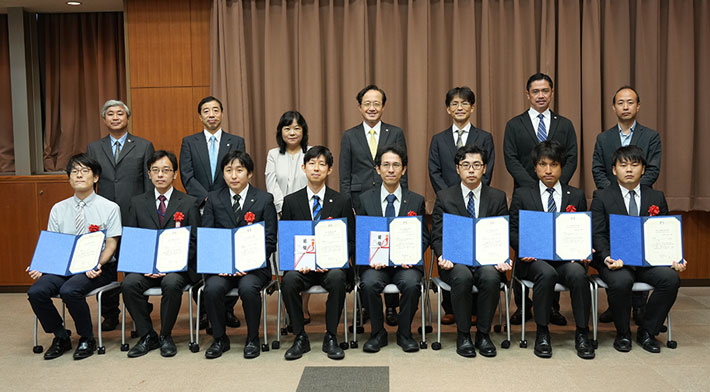
Commemorative photo with the award winners on September 1
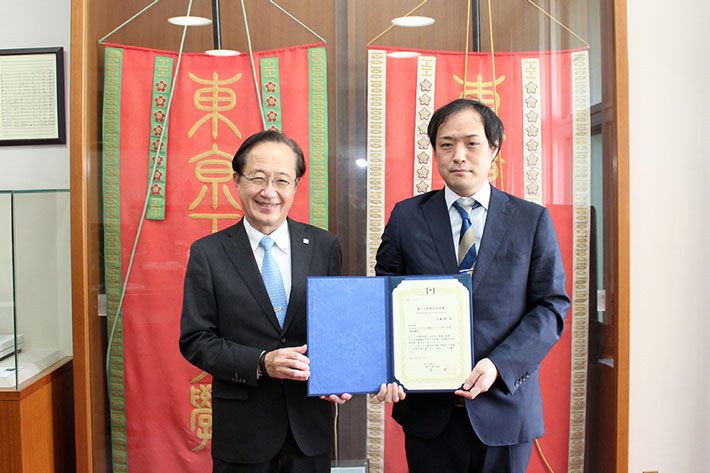
Commemorative photo with the award winner on September 12
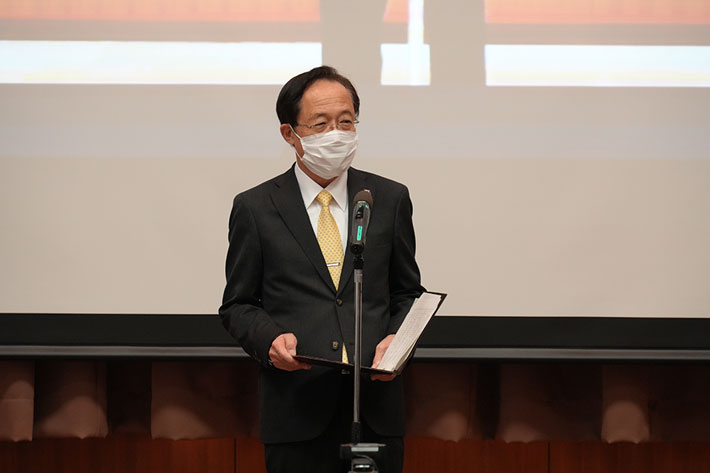
President Masu giving a congratulatory address
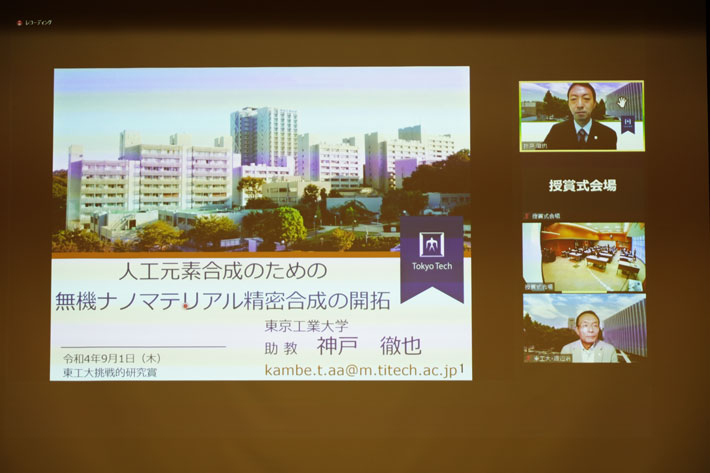
Presentation on Zoom
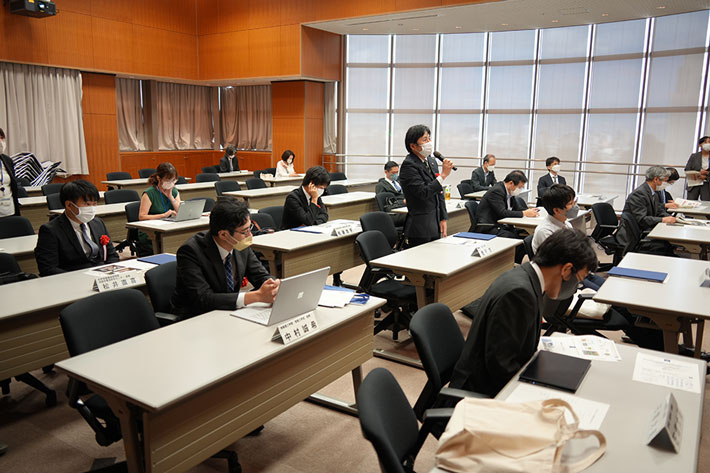
Question session after presentation
The grant was established with the aim of encouraging young faculty members at the Institute to engage in challenging research. It recognizes creative, up-and-coming researchers who boldly pursue the promotion of the most advanced research in the world, pioneering of new fields of study, innovative development of new research, and important issues that are difficult to solve. The Suematsu Challenging Research Award is given to the highest qualified researchers among the Challenging Research Award winners. This award was established by the "Suematsu Fund", which was created based on the desire of former President Yasuharu Suematsu to support young researchers. When Professor Yasuharu Suematsu received the Japan Prize in 2014, he donated a portion of the prize money to Tokyo Tech, which established the Suematsu Fund to encourage young researchers. The Fund supports mainly young researchers to encourage their research activities to predict and study the development of unexplored scientific and technological systems in diverse fields and to bring the potential future to real society.
2022 Tokyo Tech Challenging Research Award recipients
Tatsuya MIURA
Associate Professor, Department of Mathematics, School of Science
Variational and geometric analysis of higher order problems
- Tatsuya MIURA | Researcher Finder - Tokyo Tech STAR Search
- Department of Mathematics, School of Science
Hiroaki ISHIZUKA
Associate Professor, Department of Physics, School of Science
Theory of electron-lattice cooling in long-period superstructures
- Hiroaki ISHIZUKA | Researcher Finder - Tokyo Tech STAR Search
- Department of Physics, School of Science
Satoshi KANEKO
Assistant Professor, Department of Chemistry, School of Science
Control of the Physical Property of the Single-Molecule Junction Based on the Structural Analysis
- Satoshi KANEKO | Researcher Finder - Tokyo Tech STAR Search
- Department of Chemistry, School of Science
Satoshi MIURA*
Associate Professor (Lecturer), Department of Mechanical Engineering, School of Engineering
*Granted Suematsu Challenging Research Award
Development of intuitive interface considering human embodiment for teleoperated robotics
- Satoshi MIURA | Researcher Finder - Tokyo Tech STAR Search
- Department of Mechanical Engineering, School of Engineering
Ryohei ISHIGE*
Associate Professor, Department of Chemical Science and Engineering, School of Materials and Chemical Technology
*Granted Suematsu Challenging Research Award
Vertically-aligned highly functional rigid aromatic polymers utilizing smectic liquid crystal
- Ryohei ISHIGE | Researcher Finder - Tokyo Tech STAR Search
- Department of Chemical Science and Engineering, School of Materials and Chemical Technology
Yoshiki NAKAMURA
Assistant Professor, Department of Computer Science, School of Computing
Study on Computational Complexity of Logics and Calculi of Relations
- Yoshiki NAKAMURA | Researcher Finder - Tokyo Tech STAR Search
- Department of Computer Science, School of Computing
Toru KONDO
Associate Professor (Lecturer), Department of Life Science and Technology, School of Life Science and Technology
Quantum mechanism of light energy transport in biological systems
- Toru KONDO | Researcher Finder - Tokyo Tech STAR Search
- Department of Life Science and Technology, School of Life Science and Technology
Kohei SATO
Assistant Professor, Department of Life Science and Technology, School of Life Science and Technology
Stabilization of membrane proteins by honeycomb architectures
- Kohei SATO | Researcher Finder - Tokyo Tech STAR Search
- Department of Life Science and Technology, School of Life Science and Technology
Tetsuya KAMBE*
Assistant Professor, Laboratory for Chemistry and Life Science, Institute of Innovative Research
*Granted Suematsu Challenging Research Award
Development of finely-controlled synthesis for inorganic nanomaterials to realize artificial elements
- Tetsuya KAMBE | Researcher Finder - Tokyo Tech STAR Search
- Laboratory for Chemistry and Life Science, Institute of Innovative Research
Naoki MATSUI
Assistant Professor, Research Center for All-Solid-State Battery, Institute of Innovative Research
Energy and hydrogen storage devices based on hydride
- Naoki MATSUI | Researcher Finder - Tokyo Tech STAR Search
- Research Center for All-Solid-State Battery, Institute of Innovative Research
Comments from the Suematsu Challenging Research Award winners
Satoshi MIURA
Associate Professor (Lecturer), Department of Mechanical Engineering, School of Engineering
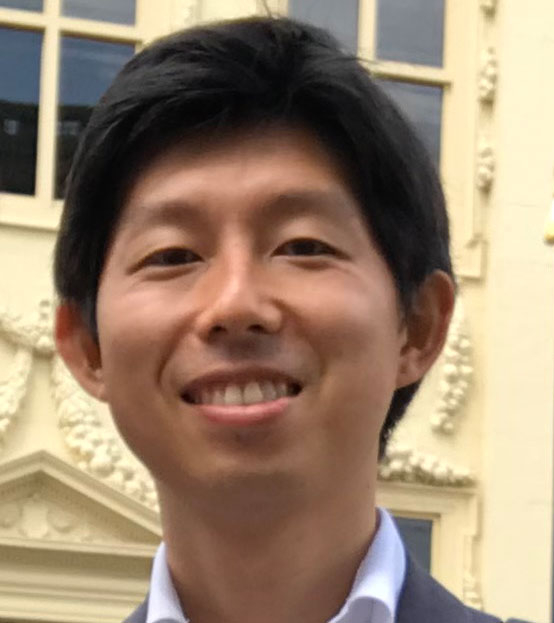
I'm very honored to receive this award. I am most grateful to the department for giving me a chance. I greatly appreciate the support of many professors, staffs, students, and my family. We have studied the robotics and AI using human bio-signal. In this research, we developed the interface realizing the intuitive operation of the tele-robot. The tele-robotics is necessary in a lot of fields such as the infrastructure, medical and services. These robots have the unique structure because the working environment is complex. Hence, the robot's structure is different from the human body. The function is called as "the Embodiment Difference". Since it is difficult to operate the robot intuitively, we need to devise the interface connecting between robot and human whose structures are different. In this study, we developed the novel structured interface and the intelligent control to achieve the intuitive operability. I hope I can continue to live up to your expectations and contribute to the further success of the Tokyo Tech. Thank you very much.
Ryohei ISHIGE
Associate Professor, Department of Chemical Science and Engineering, School of Materials and Chemical Technology
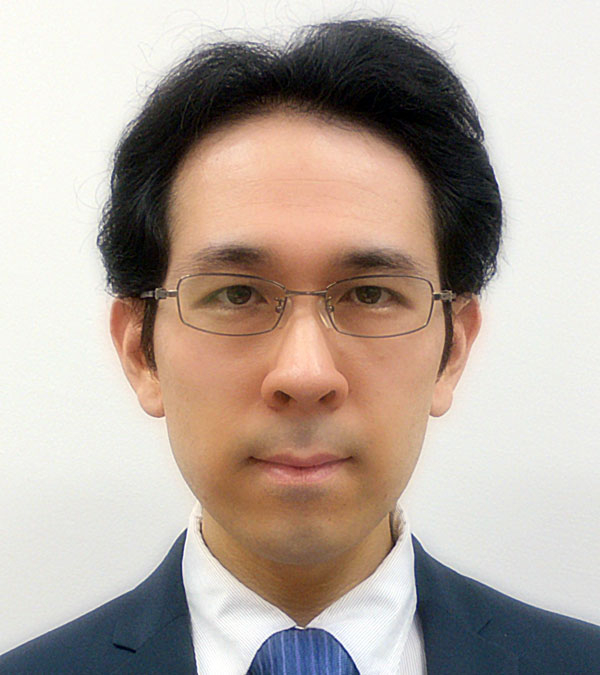
Rigid polymers such as polyimide and polythiophene, which have a rigid rod-like structure composed of aromatic rings, are used in a variety of applications ranging from insulating layers in electronic circuits to semiconductor layers in organic thin-film solar cells, because of not only their flexibility but also the excellent heat resistance beyond other flexible polymers. If these rigid polymers could be aligned perpendicularly to the film, extremely useful properties would be realized, such as high thermal and electrical conductivity in the film thickness direction. However, this is very challenging due to thermodynamic limitations. In this research, we focused on the properties of smectic liquid crystals that spontaneously form layered structures, as found in soap bubbles and cell membranes, to challenge the control of the vertical alignment of rigid polymers. Before now, we successfully fabricated unique polyimide films containing more than 70% of vertically aligned components. Finally, I am very honored to receive the prestigious Tokyo Tech Challenging Research Award and the Suematsu Challenging Research Award. I would like to express my sincere gratitude to Professor Shinji Ando for supporting this research, Mr. Shohei Hara (M.S., 2020) for collaborating this research, and all the students and graduates of our laboratory. I also would like to express my deep appreciation for the great support of Tokyo Tech for young researchers.
Tetsuya KAMBE
Assistant Professor, Laboratory for Chemistry and Life Science, Institute of Innovative Research
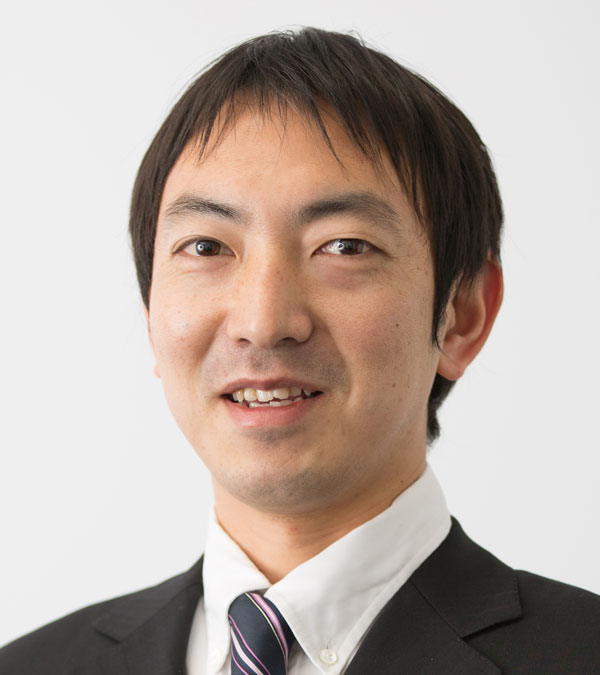
I am very honored to receive the prestigious Tokyo Tech Challenging Research Award and the Suematsu Challenging Research Award. I greatly appreciate the support of Professor Kimihisa Yamamoto, Associate Professor Takane Imaoka, the many other professors and all of the project staff and laboratory members. Superatoms are special metal particles composed of several atoms, and have been studied as promising building blocks for new materials due to the feature of having unique periodicity like atoms. In particular, it is attractive for superatoms to be able to control the electronic properties depending on the number of valence electrons, which has drawn wide attention as new materials that researchers are capable of designing the properties. However, research on superatom synthesis has been limited to either detection under high vacuum or synthesis of stable clusters using organic ligands. The aim of this research is to develop superatom synthesis with finely controlled atomicity and metallic ratios by making full use of template polymers and interfacial reactions, and eventually, to be able to synthesize various superatoms in a solution phase. Such superatoms are expected not only to replace scarce elements such as precious metals and rare earths, but also to perform as unknown elements which have new electronic state.






